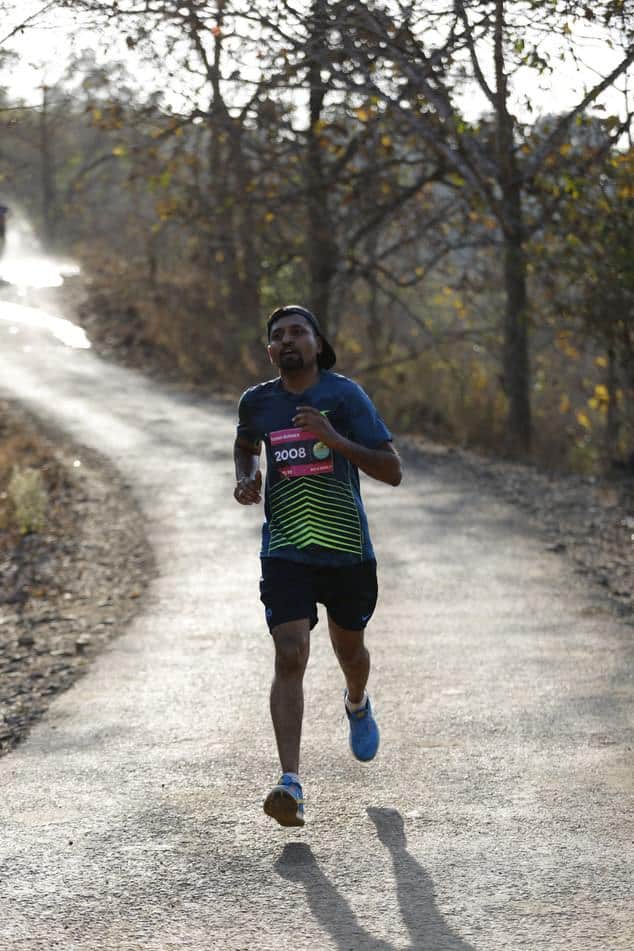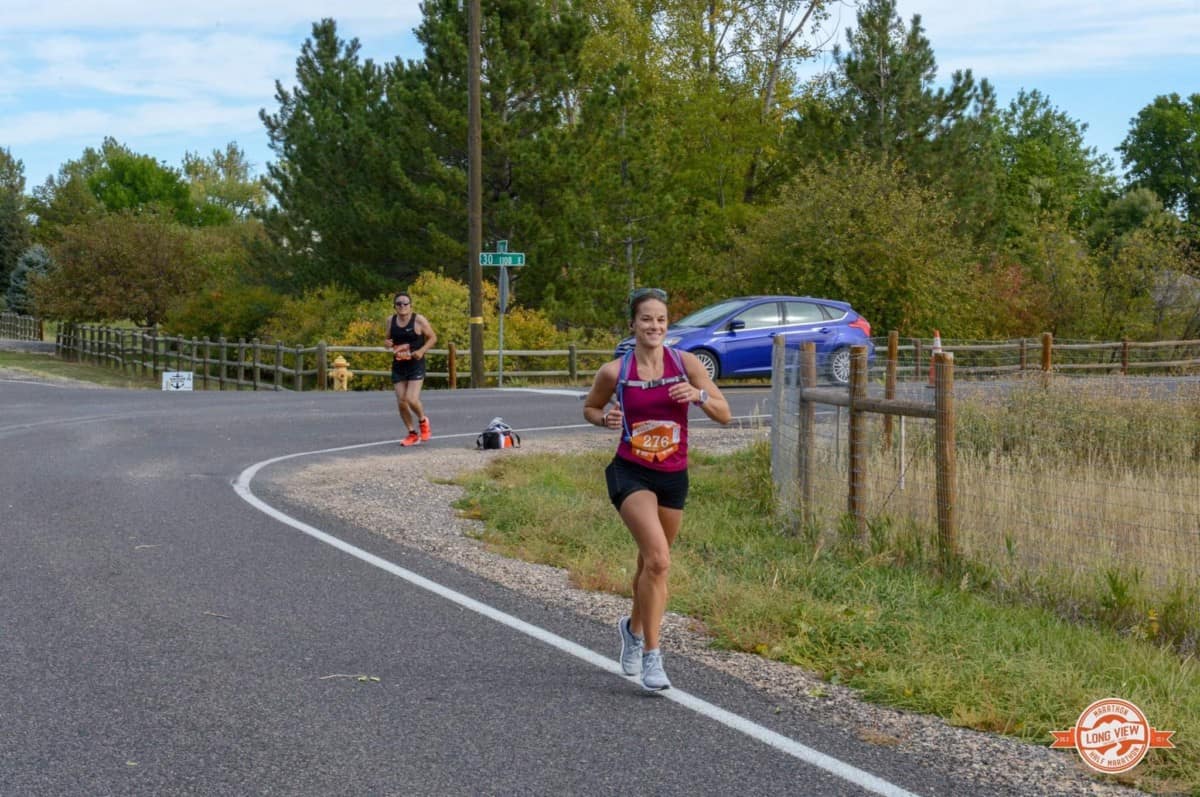One of my non-marathon running friends recently asked about “hitting the wall” in the marathon wondering if it’s a real thing. (Where you feel the sudden onset of fatigue.) I told him that unfortunately, it is very real. I’ve spent time strategizing the best ways to avoid this from happening, and want to share it with all of you. Because hitting the wall is not fun! So let’s find out why hitting the wall in a marathon happens and what steps to take to prevent it.
Hitting the wall in the marathon happens because the body can only store 2,000 calories of glycogen (the fuel you use to run) which is usually used within 20 miles. Being that the marathon is 26.2 miles long, for 6+ miles your body has to use fat for fuel which is a much less efficient process.
Luckily there are ways to train your body to push through the “wall” or even so you never feel it at all. Here you’ll learn more about what hitting the wall (also known as bonking) in a marathon feels like, why it happens, and this good stuff:
8 tips to implement to avoid hitting the wall from happening including:
- Run higher mileage in training.
- Incorporate at least 3 long runs of 20+ miles during your training.
- Put medium-long runs into your training.
- Try running “carb-free” on your easy runs.
- Practice your mental game.
- Carbo-load before your marathon.
- Don’t go out too fast.
- Follow a proper fueling/hydration strategy during the marathon that includes carbs.
Hitting the wall can be overcome!
Hitting the Wall in a Marathon: Symptoms and What it Feels Like
Though you can certainly feel exhausted in lots of sports or after a hard workout, it’s not the same as the wall that endurance athletes refer to. So it’s not to be confused with being tired and it isn’t something you’re most likely going to experience in shorter races. It COULD happen in a long training run, but isn’t likely to happen for most people in the 16 and below mileage range.
So, if it’s not just about getting tired when you run, what does hitting the wall feel like exactly?
Here’s how you know you’ve “hit the wall” or “bonked” in your race or long run:
- You’re in the 18-22 mile range
- You’ve been feeling good or great up until that point and suddenly you don’t anymore.
- You have a strong urge to walk
- a feeling of “dead legs”
- dizziness
- Negative thoughts and doubt creep in
- Both your mind and your body want to quit
- You feel completely depleted (and that’s because you are! Read on…)
This is different from being ready to quit after an intense speed session when you feel like your heart might explode. Rather, this is a pace you’ve been able to carry for maybe 20 miles or more when, with almost no warning, you feel like you can’t run anymore. And it sucks. Yet, it’s completely normal.
Why Marathon Runners Hit the Wall
Though “the wall” or “bonking” are just coined terms for this feeling, there’s actually a scientific reason behind it all.
Fortunately, it’s actually pretty easy to understand.
Your body needs energy and for most people that comes from tapping into glycogen stores. It’s essentially our fuel reserve found in our liver and muscles. Your body can also metabolize fat, but unless you’ve trained your body to do this, it’s a much slower process than using glycogen stores.
The problem is that, in general, a body can only hold about 2,000 calories worth of glycogen. Perfectly fine in everyday life, not so much for a marathon runner. Once that glycogen’s used up, your body has to start the much less efficient process of burning fat. This quick math shows where the problem lies:
2,000 calories stored up divided by (an average of) 100 calories burned per mile = hitting the wall at mile 20
If only our body stored 2,620 calories that would be so much better, right?! Darn. And some people store closer to 1,800 or so, making the bonk come that much sooner.
So many people wonder what the hardest mile of a marathon is, which I discuss in this article, and for most, it’s wherever hitting the wall decides to show up. But does it show up for everyone, or is there a way to avoid it?

Is it Possible to Avoid Hitting the Wall in a Marathon?
As a marathon runner, if you’ve ever hit the wall, then you’re in good company. According to this study of over 300 marathon runners, 43% of them reported common symptoms of hitting the wall. But common or not, it’s an encounter we’d prefer to skip if at all possible.
Top 8 Tips to Avoid Hitting the Wall in a Marathon
- Run higher mileage in training. Being able to run farther, longer, and faster is the name of the game when it comes to marathons. High mileage is a large contributing factor in how well your body can maintain your goal pace for the duration of the marathon since its purpose is to build your body’s aerobic engine. Getting in goal pace miles is important, but note that optimal long-run pace is generally about 55 – 75% of your 5k pace (as stated by Coach Jeff here on Runners Connect.)
I love using the Mcmillan calculator to figure out what paces I should be running, by the way! - Incorporate at least 3 long runs of 20+ miles during your training. The long run is probably the single best indicator of how you’ll fare in your marathon. That’s not to say that quality workouts and the rest of the mileage through your week isn’t important, but safely building those long runs week to week is what really prepares you for the main event of 26.2 miles. Though long runs should be run at much slower pace, these 20+ miler runs are like a dress rehearsal.
- Put medium-long runs into your training. I just started a new marathon training group, and my coach has a medium-long run planned each week. This will be new for me and I can’t wait to see how it helps! Even Greg Mcmillan of McMillan Running agrees that the mid-long run is an important part of building resistance against hitting the wall.
- Try running “carb-free” on your easy runs. Training without consuming carbs before or during an easy run will help your body adapt to utilizing more fat for fuel. I personally would never try this on a quality/speed workout or long run, but I do it pretty often for those easy runs of 7 miles or less.
- Practice your mental game. Yes, the physiological component of hitting the wall comes from a depletion of glycogen in your body. But, you CAN overcome it with sheer will and grit. Remember that your mind will try to give up long before your body actually would need to. The trick is to learn how to just.keep.going. Practice your positive mental strategies in your long runs and these will pay dividends in your marathon. Promise.
- Carbo-load before your marathon. You should be getting as much glycogen stored in your body (without overdoing it) in the week before your marathon. This is not the time to feel guilty about consuming those extra carbs! Your body will rely on it more than you can know. Need more info about how to go about the carbo-load? Read: The Carbo-Load: Why do marathon runners do this?
- Don’t go out too fast. This is one of the top mistakes of new marathon runners. It’s even tough to do when you know better – I’ve been there and it’s hard to pull the reigns in when you feel so good. But this will matter big time later in your race. Don’t go any faster than your goal pace in the beginning, and staying on the conservative side for the first 10k or more is a smart racing strategy. “Banking time” won’t be your friend, and you can read more about that here.
- Follow a proper fueling/hydration strategy during the marathon that includes carbs. A simple electrolyte isn’t going to cut it. You have to make sure you’re ingesting approximately 30 – 60 grams of carbohydrates every 45 minutes to 1 hour in a marathon. This can come in the form of gels, liquids, or solids – depending on what you prefer. But it needs to be easily digestible, so be sure you practice your fueling strategy during long runs before the big day. My go-to is the Sword Endurance drink. And start this early on in your marathon – do not wait!

Overcoming the Dreaded Wall Even When You Can’t Avoid It
Ultimately, there will be times when you hit the wall even when you’ve tried to do everything you could to keep it from showing up. Here’s the thing – just because it rears its ugly head, doesn’t mean you have to succumb to it. And a lot of that comes from how you choose to mentally cope with it.
In this Runner’s World Q & A with sports scientist Tim Noakes, he states that he believes the brain directs exercise performance as a way to save ourselves from overexertion by strenuous exercise. What this means is that though you may feel like you’re going to die, you’re actually not. You have to train your brain to be able to overcome the physical pain that comes with hitting the wall. You can go so much farther than you could ever imagine.
So what should you do if you’ve hit the wall? Is it possible to push through?
Unless you’re feeling dizzy or disoriented (in which case you’ll want to assess if you’re in danger with a possible visit the medic tent), you can absolutely get through bonking.
The best thing to do at this point is distract yourself in any way that you can and stay positive. Tap into your mental training that you utilized during all of your long runs. I highly recommend choosing a mantra or two you can run through your head over and over when the going gets tough. “The body achieves what the mind believes,” was mine in my last race. I probably said it to myself at least 100 times. It works!
And if you have to slow the pace down, then do so! But if you never intended to walk in your marathon, I would strongly urge you to just keep running for as long as you possibly are able.

Stand Proud No Matter What
Whether you’ve truly hit a wall or not, marathons are a grind. It is important to remember that they are unpredictable. You can have a perfect training cycle, fuel properly, and try to do everything right, and you still may end up with a less than stellar experience. But don’t forget to hold your head high when you cross that finish line. Because you just ran a freakin’ marathon.
As ultramarathoner Dean Karnazes put it, “Run when you can, walk if you have to, crawl if you must; just never give up.”







